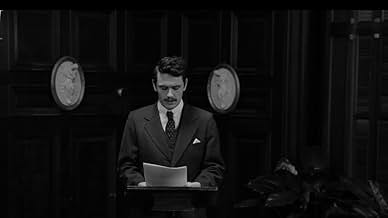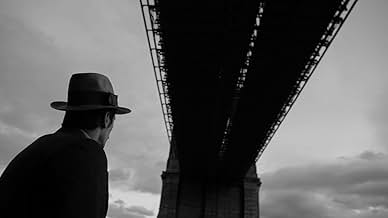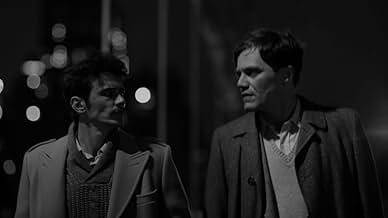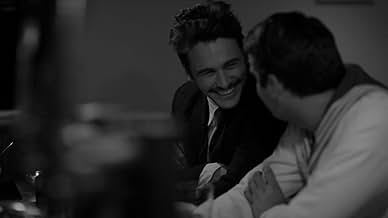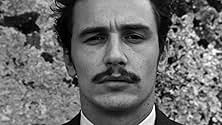Agrega una trama en tu idiomaA biography of American poet Hart Crane who committed suicide at the age of 32 by jumping off the steamship SS Orizaba.A biography of American poet Hart Crane who committed suicide at the age of 32 by jumping off the steamship SS Orizaba.A biography of American poet Hart Crane who committed suicide at the age of 32 by jumping off the steamship SS Orizaba.
- Dirección
- Guionistas
- Elenco
- Dirección
- Guionistas
- Todo el elenco y el equipo
- Producción, taquilla y más en IMDbPro
Opiniones destacadas
Set against the backdrop of 1920's New York, Paris, Cuba, and Mexico, The Broken Tower succeeds in merging two disparate art forms, film and poetry, to propel the narrative. There's also a lot of silence in this film where we are allowed to see Crane's world as through his eyes. Elegaic sequences are punctuated with cuts to black and the spare and subtle soundtrack perfectly matches the storytelling.
I admit to knowing nothing about Hart Crane before tonight's screening but I left wanting to read his poems and letters myself.
Thank you, Mr. Franco,
wlm
The subject of the film is the life and creative genius of Hart Crane, (July 21, 1899 - April 27, 1932) an American poet who found both inspiration and provocation in the poetry of T. S. Eliot, Crane wrote modernist poetry that is difficult, highly stylized, and very ambitious in its scope. In his most ambitious work, The Bridge, Crane sought to write an epic poem in the vein of The Waste Land that expressed something more sincere and optimistic than the ironic despair that Crane found in Eliot's poetry. In the years following his suicide at the age of 32, Crane has come to be seen as one of the most influential poets of his generation.
James Franco wrote the screenplay based on book by Paul Mariani, directed and edited the film and acted the main role of Hart Crane. Crane was a nearly disconsolate man who refused to follow his wealthy father's business, longing instead to be a poet. Born in Ohio he traveled to New York (the place he always considered home), to Cuba, and to Paris searching for his poetic voice. He was a gay man in an era when his lifestyle was always under threat, he had a lover (Vince Jolivette) early on in an affair that was filled with passion, and in his travels he seemed to find his true love in Emile (Michael Shannon) that endured the manic highs and depressive, death-haunted lows that befell this self -destructive visionary poet. He attempted suicide at least once and finally ended his life in a successful suicide at the young age of 32.
Franco breathes life into Hart Crane, offering more understanding of this enigmatic genius than we have ever been afforded. In making the film Franco uses his younger brother Dave Franco to depict the young Hart and selects his small cast wisely. The film is completely in black and white and is in the format of 'Voyages' - each voyage takes us through a distinct part of Hart's life: his gay loves, his poetry readings, his forays to Cuba and to Paris and his lonely hours of sitting before an old typewriter where he created the major epics of poetry that remain some of the finest ever written by an American poet.
The film is choppy, not unlike the manner in which Hart's mind worked in bits and pieces, always immersed in thoughts of the sea, the labor of common man, of the Brooklyn Bridge which would play the major role in his most famous epic poem THE BRIDGE, and of the fellow artists whose work he so admired. There is a strange musical score (the work of Neil Benezra) which is long on choral chanting, and a quality of gritty cinematography achieved by Christiana Vorn. The technique of the making of this film matches the vision of James Franco in continuing to visit the lives of isolated geniuses. The dialogue, what little there is, is Crane's poetry as spoken by Franco.
For many this film will seem self-indulgent on Franco's part. And perhaps it partially is. But the flavor of this gay American poet of the 1920s and the reflections of America at that time ring true. THE BROKEN TOWER is not a biopic of Hart Crane. It is an elegy.
Grady Harp
"The Broken Tower" is shot in black and white. It is a tell tale sign that it is a very artsy movie that has no commercial elements at all. I tried very hard to enjoy it, trying to appreciate the slowness of the pace, and trying to enjoy the beauty of the literature reading. However, there is really very little plot in the film, and the story is told in a very scattered manner. For every 30 seconds of plot, there are five minutes of self indulgent filler scenes. I got quite tired of watching James Franco walking around or sitting around. We also see a lot of Hart's sexual liaisons, ranging from walking up the stairs with another man, to apparently non-simulated oral sex.
After watching the whole film, I did not gain an insight into Hart's life, but rather it felt more like a project for James Franco to expose the exploration his sexuality.
¿Sabías que…?
- TriviaShot in three countries and 30 locations in 15 days.
- ErroresThe dress, hair, and make-up of the Peggy character are all wrong for 1931.
- Citas
Gorham Munson: Hart, forgive me for saying this. But you want to speak for America.
Hart Crane: Yeah.
Gorham Munson: Does it matter that you're queer?
Hart Crane: [Annoyed, rolls eyes] Whitman was queer. That's why he could love *all* of America. The roustabouts. The slaves. The, the soldiers he nursed in the Civil War.
Gorham Munson: So you will expose yourself?
Hart Crane: It's funny, considering my truckdriver left me. No. People can know everything about us when we're dead. But for now, it's better to keep quiet. For father's sake.
Gorham Munson: [sarcastically] Right. You wouldn't want to lose that tremendous job for the sake of some queer affirmation.
- ConexionesReferenced in Hart Crane: An Exegesis (2012)
Selecciones populares
- How long is The Broken Tower?Con tecnología de Alexa
Detalles
- Tiempo de ejecución1 hora 39 minutos
- Color
- Relación de aspecto
- 1.85 : 1


